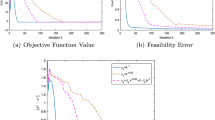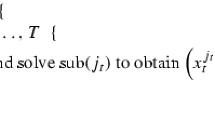Abstract
For a risk-averse multistage stochastic optimization problem with a finite scenario tree, we introduce a new scenario decomposition method and we prove its convergence. The main idea of the method is to construct a family of risk-neutral approximations of the problem. The method is applied to a risk-averse inventory and assembly problem. In addition, we develop a partially regularized bundle method for nonsmooth optimization.
Similar content being viewed by others
References
Artzner, P., Delbaen, F., Eber, J.-M., & Heath, D. (1999). Coherent measures of risk. Mathematical Finance, 9, 203–228.
Artzner, P., Delbaen, F., Eber, J.-M., & Heath, D. (2002). Coherent measures of risk, risk management: value at risk and beyond (pp. 145–175). Cambridge: Cambridge Univ. Press. (Cambridge, 1998).
Artzner, P., Delbaen, F., Eber, J.-M., Heath, D., & Ku, H. (2007). Coherent multiperiod risk adjusted values and Bellman’s principle. Annals of Operations Research, 152, 5–22.
Aubin, J.-P., & Frankowska, H. (1990). Set-valued analysis. Boston: Birkhäuser.
Bertsekas, D., & Tseng, P. (1994). Partial proximal minimization algorithms for convex programming. SIAM Journal on Optimization, 4(3), 551–572.
Birge, J. R., & Louveaux, F. V. (1988). A multicut algorithm for two-stage stochastic linear programs. European Journal of Operational Research, 34, 384–392.
Birge, J. R., & Louveaux, F. V. (1997). Introduction to stochastic programming. New York: Springer.
Cheridito, P., Delbaen, F., & Kupper, M. (2006). Dynamic monetary risk measures for bounded discrete-time processes. Electronic Journal of Probability, 11, 57–106.
Collado, R. A. (2010). Scenario decomposition of risk-averse mustistage stochastic programming problems. PhD Dissertation, Rutgers University.
Föllmer, H., & Schied, A. (2004). Stochastic finance. An introduction in discrete time. Berlin: Walter de Gruyter.
Fritelli, M., & Scandolo, G. (2006). Risk measures and capital requirements for processes. Mathematical Finance, 16, 589–612.
Fritelli, M., & Rosazza Gianin, E. (2002). Putting order in risk measures. Journal of Banking & Finance, 26, 1473–1486.
Hiriart-Urruty, J.-B., & Lemaréchal, C. (1993). Convex analysis and minimization algorithms. Berlin: Springer.
Kall, P., & Mayer, J. (2005). Stochastic linear programming. New York: Springer.
Kiwiel, K. C. (1983). An aggregate subgradient method for nonsmooth convex minimization. Mathematical Programming, 27, 320–341.
Kiwiel, K. C. (1985). Methods of descent for nondifferentiable optimization. In Lecture notes in mathematics (Vol. 1133). Berlin: Springer.
Miller, N., & Ruszczyński, A. (2011). Risk-averse two-stage stochastic linear programming: modeling and decomposition. Operations Research, Articles in Advance, 59, 125–132. doi:10.1287/opre.1100.0845.
Mulvey, J. M., & Ruszczyński, A. (1995). A new scenario decomposition method for large-scale stochastic optimization. Operations Research, 43, 477–490.
Pflug, G. Ch., & Römisch, W. (2007). Modeling, measuring and managing risk. Singapore: World Scientific.
Prékopa, A. (1995). Stochastic programming. Dordrecht: Kluwer.
Riedel, F. (2004). Dynamic coherent risk measures. Stochastic Processes and Their Applications, 112, 185–200.
Rockafellar, R. T., Uryasev, S., & Zabarankin, M. (2006). Deviation measures in risk analysis and optimization. Finance and Stochastics, 10, 51–74.
Ruszczyński, A. (1986). A regularized decomposition method for minimizing a sum of polyhedral functions. Mathematical Programming, 35, 309–333.
Ruszczyński, A. (2003). Decomposition methods. In Handbooks oper. res. management sci.: Vol. 10. Stochastic programming (pp. 141–211). Elsevier: Amsterdam.
Ruszczyński, A. (2006). Nonlinear optimization. Princeton: Princeton University Press.
Ruszczyński, A. (2010). Risk-averse dynamic programming for Markov decision processes. Mathematical Programming, 125, 235–261.
Ruszczyński, A., & Shapiro, A. (2005). Optimization of risk measures. In G. Calafiore & F. Dabbene (Eds.), Probabilistic and randomized methods for design under uncertainty. London: Springer.
Ruszczyński, A., & Shapiro, A. (2006a). Optimization of convex risk functions. Mathematics of Operations Research, 31, 433–452.
Ruszczyński, A., & Shapiro, A. (2006b). Conditional risk mappings. Mathematics of Operations Research, 31, 544–561.
Ruszczyński, A., & Shapiro, A. (2007). Corrigendum to: “Optimization of convex risk functions,” Mathematics of Operations Research, 31, 433–452 (2006). Mathematics of Operations Research, 32, 496.
Scandolo, G. (2003) Risk measures in a dynamic setting. PhD Thesis, Università degli Studi di Milano, Milan.
Shapiro, A., Dentcheva, D., & Ruszczyński, A. (2009). MPS-SIAM series on optimization: Vol. 9. Lectures on stochastic programming: modeling and theory. Philadelphia: MPS-SIAM.
Author information
Authors and Affiliations
Corresponding author
Additional information
This paper is dedicated to András Prékopa on the occasion of his 80th birthday.
Rights and permissions
About this article
Cite this article
Collado, R.A., Papp, D. & Ruszczyński, A. Scenario decomposition of risk-averse multistage stochastic programming problems. Ann Oper Res 200, 147–170 (2012). https://doi.org/10.1007/s10479-011-0935-y
Published:
Issue Date:
DOI: https://doi.org/10.1007/s10479-011-0935-y




